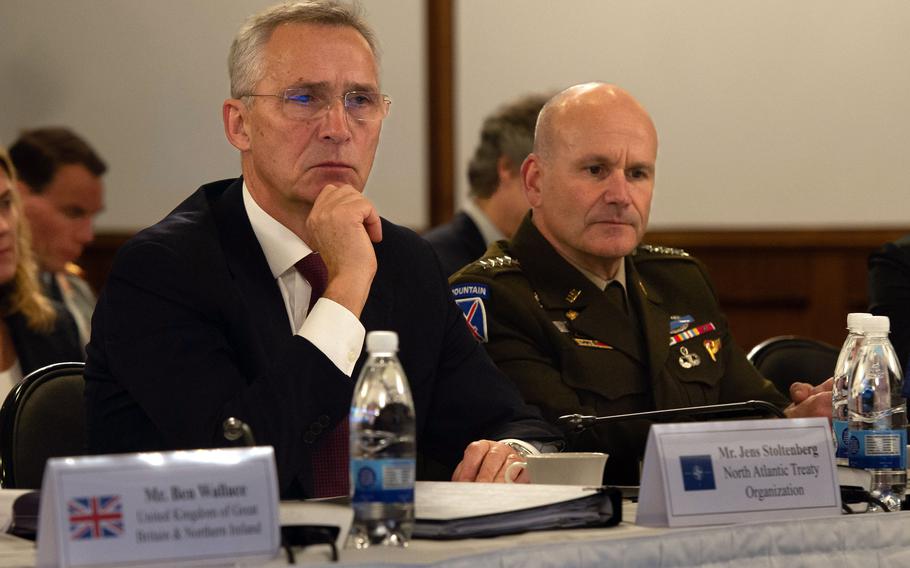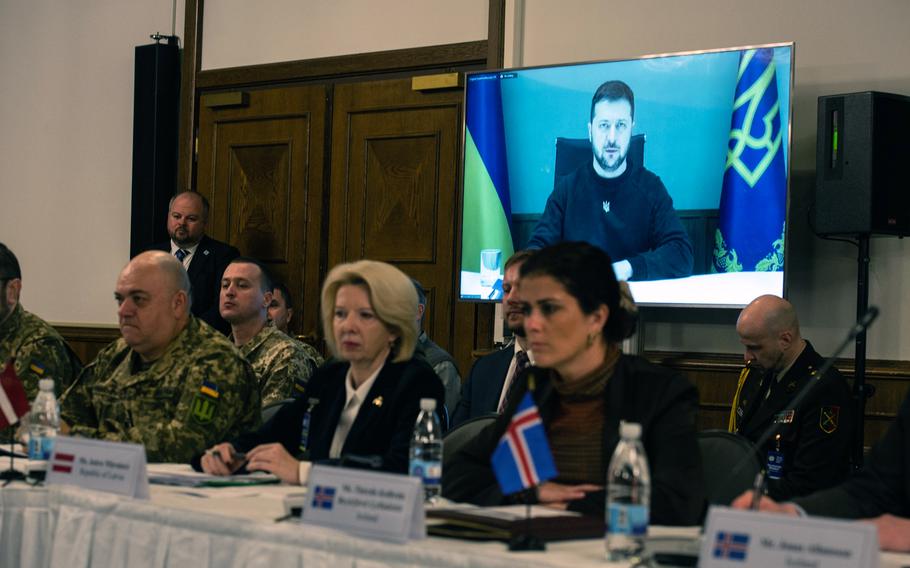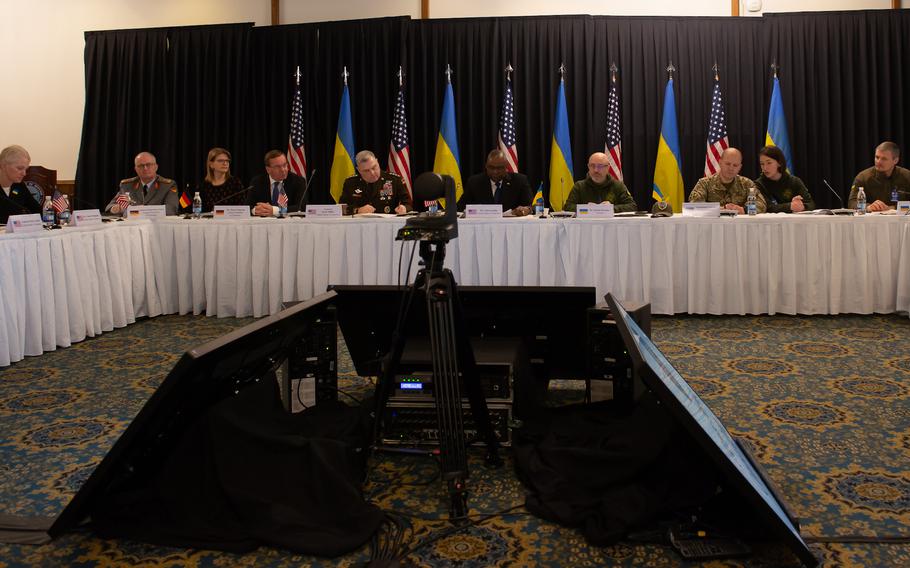
NATO Secretary-General Jens Stoltenberg and U.S. Army Gen. Christopher Cavoli, who serves as the commander of U.S. European Command and NATO supreme allied commander, listen to a video message from Ukrainian president Volodymyr Zelenskyy during the Ukraine Defense Contact Group meeting on Friday, Jan. 20, 2023, at Ramstein Air Base, Germany. (Alexander Riedel/Stars and Stripes)
Updated at 7:39 p.m., Central European Time
RAMSTEIN AIR BASE, Germany — President Volodymyr Zelenskyy on Friday asked allied defense leaders gathered here for the advanced weapons he said are necessary to end Russia’s invasion, but talks ended without an agreement from Germany to send its advanced Leopard 2 tanks into the war-torn country.
“I encourage you to make such decisions that can deprive Russia … of any power,” Zelenskyy said in a live video feed during opening remarks of the Ukraine Defense Contact Group conference. “We have to speed up.”
U.S. Defense Secretary Lloyd Austin brushed aside notions of anything but unity with Germany, emphasizing the contributions by allies of other types of armored vehicles, ammunition and air defenses to Ukraine, nearly 11 months since Russia’s full-scale invasion began.
“This isn’t really about one single platform,” Austin said in closing remarks, which came after leaders from 54 nations met for hours behind closed doors at the Ramstein Officers’ Club. “Our goal is to provide the capabilities that Ukraine needs to be successful right now.”
However, pressure is mounting within NATO to provide Ukraine with more armored weaponry, including modern tanks, amid fears Russia is planning a renewed spring offensive in the war.
So far, Germany has balked at the idea of providing tanks. Officials in Berlin had told German media for days that they would offer the Leopard 2 only if the United States agreed to provide Ukraine with M1 Abrams tanks.
Austin disputed that notion on Friday.
“I think you heard the German (defense) minister say today there’s no linkage between providing M1s and providing Leopards,” Austin said, adding he had no announcements to make about Abrams tanks.
Earlier in the day on the sidelines of the talks, German Defense Minister Boris Pistorius said his government was reviewing any potential consequences of providing tanks to Ukraine.
“We are not hesitant, we are careful,” Pistorius said.
Pistorius, in his second day as the head of Germany’s military, said he’s not worried about Ukraine losing the war if Berlin doesn’t act.
“We will make our decision as soon as possible,” he told reporters. “We support Ukraine in a very big measure, and we will continue to do this.”
Washington has been reluctant to send Abrams tanks to Ukraine due to their considerable training, fueling and maintenance requirements.
The German prohibition thus far extends to the tanks they’ve made and sold to other allies, despite nations such as Poland actively supporting sending Leopard 2 tanks to Ukraine. Weapons contracts often contain language that prevents re-export to other nations.
Austin on Friday reiterated yesterday’s announcement by Pentagon officials of $2.5 billion in new weapons aid for Ukraine, including Bradley fighting vehicles, and for the first time, highly mobile Stryker combat vehicles.
It’s one of the largest packages yet, bringing the U.S. contribution to more than $27.4 billion in security assistance to Ukraine since Russia launched its full-scale invasion in late February.
Austin on stressed this was not the time “to let up.”
“Russia is regrouping, recruiting and trying to reequip,” he said. “This is not a moment to slow down. It’s a time to dig deeper.”
Allies and partners have so far provided Ukraine with about 900 armored personnel carriers, according to DOD, and NATO allies are training Ukrainian forces in Europe and in the United States.

International defense officials listen to a video message from Ukrainian President Volodymyr Zelenskyy during the Ukraine Defense Contact Group meeting on Friday, Jan. 20, 2023, at Ramstein Air Base, Germany. Zelenskyy expressed thanks for continued support but said new commitments will be needed for Ukraine to continue its fight against Russia. (Alexander Riedel/Stars and Stripes)
But Ukraine needs more modern, mechanized armored capabilities, which Germany is well-positioned to provide, U.S. officials said this week.
The United Kingdom earlier agreed to send some of its Challenger 2 tanks, which would be the first Western tanks Ukraine receives.
Meanwhile, the U.K., France and Germany will send air defense systems; Sweden will donate CV90 infantry fighting vehicles; Latvia will provide Stinger missiles and helicopters; and Estonia is sending howitzers and munitions, Austin said, in naming some of the alliance’s new contributions.
The equipment still must be assembled and delivered, and troops have to be trained.
“That will be a very, very heavy lift,” said Army Gen. Mark Milley, chairman of the Joint Chiefs of Staff. “I think it can be done but it will be a challenge, there’s no question about it, so we’ll see. The Ukrainian forces so far have executed at least two, perhaps even more than that, very successful offensive operations.”
Milley added that the Russians have suffered “significantly more” than 100,000 casualties since the war started, and told Russian President Vladimir Putin to end his war of choice.
“It’s turning into an absolute catastrophe for Russia,” Milley said.
Russia shows no sign that it’s willing to engage in serious peace talks, NATO Secretary-General Jens Stoltenberg said at the meeting Friday.
“The aim of Russia is still to win on the battlefield, so therefore the reality is that most likely this war will end at the negotiating table,” he said.
Ukraine needs battlefield success for when those negotiations eventually occur, Stoltenberg said.
To ensure “Ukraine prevails as a sovereign, democratic, independent nation in Europe … we need to provide military support to Ukraine now,” he said.

International defense officials listen to a video message from Ukrainian President Volodymyr Zelenskyy during the Ukraine Defense Contact Group meeting on Friday, Jan. 20, 2023, at Ramstein Air Base, Germany. (Alexander Riedel/Stars and Stripes)